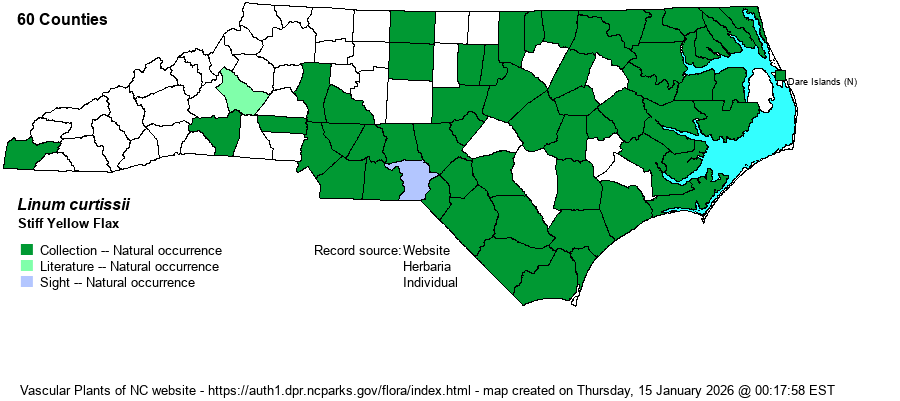| Author | Small | |
| Distribution | Throughout the Coastal Plain and the eastern Piedmont; sparingly in the central and western Piedmont, and only one record known westward, from the southwestern Mountains (Cherokee County).
This is an Eastern species, ranging from ME and MI, south to southern FL and TX. | |
| Abundance | Fairly common to common in the Coastal Plain and southeastern Piedmont; uncommon in the central Piedmont. Very rare in the southwestern Mountains. | |
| Habitat | In VA this species grows in "Dry, open forests, woodlands, barrens, and roadsides; sometimes in barren, periodically wet habitats such as shallow interdune swales or outcrops with seepage" (Digital Atlas of the Virginia Flora website). However, RAB (1968) and Godfrey and Wooten (1981) list essentially only wetland habitats for "it" -- L. medium (and its various taxa), though essentially limited to acidic wetlands near or under pines (savannas, flatwoods, etc.). Sorrie (2011) says it generally occurs "on roadsides and in rights-of-way" in the Sandhills region of NC, SC, and GA. Clearly, the species does not occur in strongly wet or very damp, muddy places such as marshes, ditches, pond and lake margins, and other rich-soil sites; but it is typically found in association with pinelands and sandy soil, sometimes damp and sometimes dry. | |
| Phenology | Blooms and fruits from June to October. | |
| Identification | The Linum species are quite difficult to identify, especially as many of the former varieties and subspecies have now been elevated to full species. All are erect herbs to 1-2 feet tall, with slender branches that are usually ascending, small and narrow leaves, and numerous scattered small yellow flowers (with 5 petals) along the upper portions of the branches. From Weakley's (2018) key, this species has: "Fruit broader than long, its apex depressed, flattened, or broadly rounded; (1.3-) 1.5-2.1 (-2.3) mm long; leaves mostly 1.9-9.3 mm wide", and "Margins of the inner sepals with conspicuous stalked glands; mature fruits of dried specimens usually adhering to the plant". | |
| Taxonomic Comments | This species was generally considered as a variety of L. virginianum by many references, named as L. virginianum var. medium. Other references did or still do name it as L. medium, particularly L. medium var. texanum. Few actually name it as L. curtissii, as does Weakley (2018), which this website follows.
Website editors have received much help in species boundaries and in identification from Rogers (1963, 1984). | |
| Other Common Name(s) | Common Yellow Flax | |
| State Rank | S5 | |
| Global Rank | GNR [G5?] | |
| State Status | | |
| US Status | | |
| USACE-agcp | | |
| USACE-emp | | |

